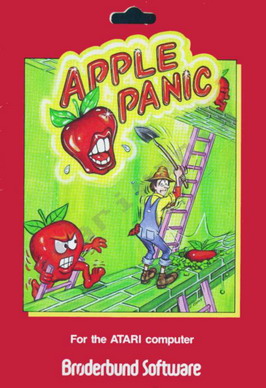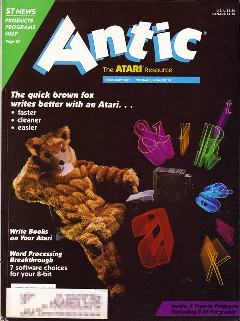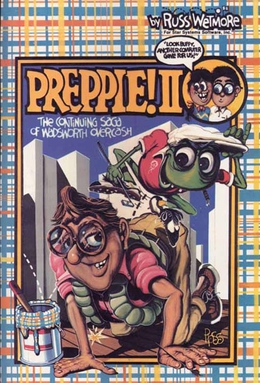Related Research Articles

The Atari 8-bit computers, formally launched as the Atari Home Computer System, are a series of 8-bit home computers introduced by Atari, Inc. in 1979 with the Atari 400 and Atari 800. It is the first home computer architecture with coprocessors, enabling more advanced graphics and sound than most of its contemporaries. Video games are key to its software library, and the 1980 first-person space combat simulator Star Raiders is considered the platform's killer app.

Zaxxon is a scrolling shooter developed and released by Sega as an arcade video game in 1982. The player pilots a ship through heavily defended space fortresses. Japanese electronics company Ikegami Tsushinki was also involved in the game's development.

Scott Adams is an American entrepreneur, computer programmer, and video game designer. He co-founded, with then-wife Alexis, Adventure International in 1979. The company developed and published video games for home computers. The cornerstone products of Adventure International in its early years were the Adventure series of text adventures written by Adams.

Shamus is a shooter with light action-adventure game elements written by Cathryn Mataga and published by Synapse Software. The original Atari 8-bit computer version was released on disk and tape in 1982. According to Synapse co-founder Ihor Wolosenko, Shamus made the company famous by giving it a reputation for quality. "Funeral March of a Marionette", the theme song from Alfred Hitchcock Presents, plays on the title screen.

Sea Dragon is a horizontally scrolling shooter for the TRS-80 computer written by Wayne Westmoreland and Terry Gilman and released in 1982 by Adventure International. The gameplay is similar to the Scramble arcade game, but underwater. It was ported to the Apple II, Atari 8-bit family, Commodore 64, TRS-80 Color Computer, and MS-DOS.
HomePak, published in 1984 by Batteries Included, is an integrated application written for the Atari 8-bit family and ported to the Commodore 64, Commodore 128, IBM PCjr, and Apple II. It includes a word processor (HomeText), database (HomeFind), and terminal communications program (HomeTerm). HomePak was designed by Russ Wetmore for Star Systems Software, Inc. The Commodore 128 version was ported by Sean M. Puckett and Scott S. Smith.

Apple Panic is a game for the Apple II programmed by Ben Serki and published by Broderbund Software in 1981. Apple Panic is an unauthorized version of the 1980 arcade game Space Panic, the first game with ladders and platforms. While the arcade original remained obscure, Apple Panic became a top seller for home computers. It was ported to the Atari 8-bit computers, VIC-20, IBM PC, and TRS-80.

Antic was a print magazine devoted to Atari 8-bit computers and later the Atari ST. It was named after the ANTIC chip in the 8-bit line which, in concert with CTIA or GTIA, generates the display. The magazine was published by Antic Publishing from April 1982 until June/July 1990. Antic printed type-in programs, reviews, and tutorials, among other articles. Each issue contained one type-in game as "Game of the Month." In 1986, STart magazine was spun off to exclusively cover the Atari ST line.

ANALOG Computing was an American computer magazine devoted to Atari 8-bit computers. It was published from 1981 until 1989. In addition to reviews and tutorials, ANALOG printed multiple programs in each issue for users to type in. Almost every issue included a machine language video game—as opposed to Atari BASIC—which were uncommon in competing magazines. Such games were accompanied by the assembly language source code. ANALOG also sold commercial games, two books of type-in software, and access to a custom bulletin-board system. After the Atari ST was released, coverage of the new systems moved to an ST-Log section of the magazine before spinning off into a separate publication under the ST-Log name.
Synapse Software Corporation was an American software developer and publisher founded in 1981 by Ihor Wolosenko and Ken Grant. Synapse published application software and developer tools and was primarily known for video games. It initially focused on the Atari 8-bit family, then later developed for the Commodore 64 and other systems. Synapse was purchased by Broderbund in late 1984 and the Synapse label retired in 1985.
Antic Software was a software company associated with Antic, a magazine for Atari 8-bit computers. Bound into issues of the magazine, the Antic Software catalog initially sold Atari 8-bit games, applications, and utilities from the recently defunct Atari Program Exchange. Original submissions were later added, as well as public domain collections, with all software provided on self-documented disk. When the Atari ST was released, it became a mixture of Atari 8-bit and Atari ST software and sold some major Atari ST titles such as CAD-3D. The magazine insert changed names several times, eventually being branded as The Catalog.

Many games, utilities, and educational programs were available for Atari 8-bit computers. Atari, Inc. was primarily the publisher following the launch of the Atari 400/800 in 1979, then increasingly by third parties. Atari also distributed "user written" software through the Atari Program Exchange from 1981 to 1984. After APX folded, many titles were picked up by Antic Software.

Dandy is a dungeon crawl maze game for Atari 8-bit computers published by the Atari Program Exchange in 1983. It is one of the first video games with four-player, simultaneous cooperative play. Players equipped with bows and unlimited arrows fight through a maze containing monsters, monster spawners, keys, locked doors, food, and bombs in search of the exit leading to the next level. If a player dies, they can be revived by finding and shooting a heart. The game includes an editor for making new dungeons.

Rear Guard is a horizontally scrolling shooter written for the Atari 8-bit family and released in December 1981 by Adventure International. Neil Larimer created the game with assistance from Sparky Starks. It was ported to the Apple II, TRS-80, and TRS-80 Color Computer.
Adventure International was an American video game publishing company that existed from 1979 until 1986. It was started by Scott and Alexis Adams. Their games were notable for being the first implementation of the adventure genre to run on a microcomputer system. The adventure game concept originally came from Colossal Cave Adventure which ran strictly on large mainframe systems at the time.

Transylvania is an adventure video game published by Penguin Software. It was released for the Apple II in 1982 followed by ports to the Atari 8-bit family and Commodore 64. A Macintosh conversion was published in 1984, then versions for the Amiga, Atari ST, and MS-DOS in 1985.

Preppie! is an action video game for Atari 8-bit computers published by Adventure International in 1982. It was programmed by Russ Wetmore of Star Systems Software, whose name is prominently displayed on the box cover. Leaning on the preppy trend of the early 1980s, the game follows prep schooler Wadsworth Overcash as he navigates the hazards of a country club to retrieve golf balls. Preppie! borrows heavily from Konami's Frogger, with lanes of traffic in the bottom half of the screen and a river crossing the top portion. Alligators are an element from both Frogger and preppy fashion; an open-mouthed gator is the icon of shirt brand Izod. Reviewers recognized the game as derivative, but called the music and visuals some of the best for Atari 8-bit computers.
Tom Hudson is an American programmer best known for co-creating the 3D modeling and animation package 3D Studio as well as creating its precursor, CAD-3D for the Atari ST.

Preppie! II is a video game written by Russ Wetmore for Atari 8-bit computers and published by Adventure International in 1983. Subtitled "The continuing saga of Wadsworth Overcash", it is a sequel to 1982's Frogger-inspired Preppie!. The game loosely continues the preppy theme, primarily through a story in the manual, but replaces the country club setting with an abstract, overhead view maze. Some obstacles from the first game appear in the second.
References
- 1 2 "Russ Wetmore". LinkedIn.
- 1 2 3 4 5 Covert, Colin (September 1983). "Russ Wetmore: Prepped for Success". Electronic Games: 86–89.
- ↑ Reed, Matthew. "Sea Dragon". TRS-80.org.
- ↑ "Preppie II". Atari Mania.
- 1 2 Savetz, Kevin (January 4, 2016). "ANTIC Interview 113 - Russ Wetmore, Preppie!, Sea Dragon, HomePak". ANTIC the 8-bit Podcast.
- ↑ "Preppie Three? - Atari 8-Bit Computer Forums". Atari Age. February 20, 2005.
- ↑ Davison, John S. "HomePak Review". Page 6 (23): 32.
- ↑ Small, David (May 1985). "Outpost: Atari". Creative Computing. 11 (5): 94.
- 1 2 "HomeCard advertisement". Antic. 4 (3): 26. July 1985.
- ↑ Wetmore, Russ (May 1985). "On-Line (column)". ANALOG Computing. No. 30. p. 28.